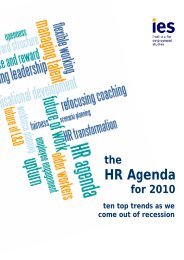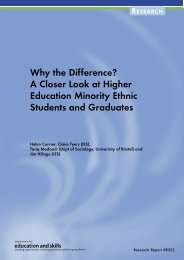Post-16 Transitions: a Longitudinal Study of Young People with ...
Post-16 Transitions: a Longitudinal Study of Young People with ...
Post-16 Transitions: a Longitudinal Study of Young People with ...
You also want an ePaper? Increase the reach of your titles
YUMPU automatically turns print PDFs into web optimized ePapers that Google loves.
abilities and how far her previous experiences have damaged her<br />
to the extent that she cannot use the abilities she has. Not<br />
surprisingly, she is extremely insecure and finds change difficult to<br />
tolerate. However, the way she sees herself, the way her foster<br />
parent see her and the way she is viewed by other pr<strong>of</strong>essionals<br />
varied considerably.<br />
These discrepancies about the ‘needs’ <strong>of</strong> young people are not<br />
uncommon where the difficulties experienced by young people do<br />
not fall into ‘standard’ disability categories or are complicated by<br />
other factors. A number <strong>of</strong> examples illustrate how young people<br />
are being allowed to embark on options that have proved for one<br />
reason or another to be inappropriate. In these cases, the issue is<br />
not simply lack <strong>of</strong> support as such. There are enough pr<strong>of</strong>essionals<br />
involved <strong>with</strong> these young people to <strong>of</strong>fer adequate levels <strong>of</strong> support<br />
and some at least <strong>of</strong> them are making strenuous efforts so to do.<br />
However, the nature <strong>of</strong> these young people’s difficulties means that<br />
the most appropriate form <strong>of</strong> placement and the level <strong>of</strong> support<br />
necessary are not immediately obvious. The providers <strong>of</strong> the young<br />
person’s current activity do what they can, but there seems to be no<br />
pr<strong>of</strong>essional who both has an overview <strong>of</strong> the case and is actively<br />
involved in shaping provision to meet the young person’s needs.<br />
6.1.3 Support losses and gains<br />
Sixteen per cent <strong>of</strong> parents/carers have stated that some <strong>of</strong> the<br />
additional support that was available to the young person<br />
whilst they were in compulsory schooling is no longer<br />
available post-<strong>16</strong>. Perhaps not surprisingly, parents and carers<br />
whose children were statemented whilst at school were twice<br />
as likely as parents and carers <strong>of</strong> those <strong>with</strong>out statements to<br />
report this to be the case.<br />
In the main, the type <strong>of</strong> support that had been most commonly<br />
lost related to: (see Table 6.3)<br />
• learning support<br />
• SENCO/tutor support, and<br />
• individual or one-to-one help.<br />
Parents were asked to say how the loss <strong>of</strong> these types <strong>of</strong><br />
support had impacted on the young person (Table 6.4)<br />
Interestingly, over one-quarter <strong>of</strong> parents and carers reporting<br />
that additional support had been lost reflected that this had<br />
had no effect on the young person whatsoever. However, as<br />
might be expected, the <strong>with</strong>drawal <strong>of</strong> (some <strong>of</strong>) this support<br />
had led primarily to:<br />
94<br />
<strong>Post</strong>-<strong>16</strong> <strong>Transitions</strong> <strong>of</strong> <strong>Young</strong> <strong>People</strong> <strong>with</strong> SEN: Wave 2

















